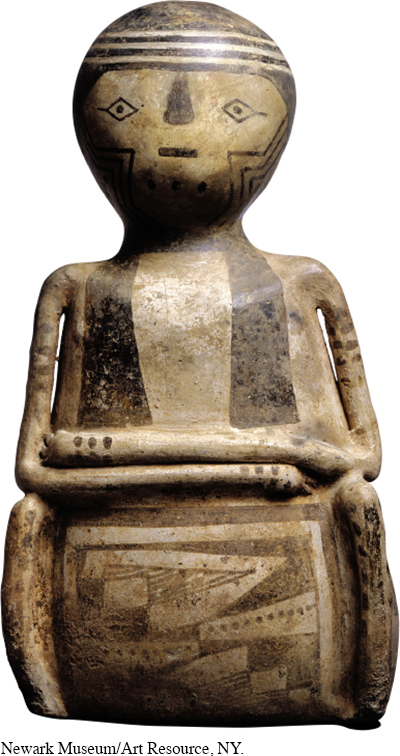Southwestern Cultures
Ancient Americans in present-day Arizona, New Mexico, and southern portions of Utah and Colorado developed cultures characterized by agricultural settlements and multiunit dwellings called pueblos. All southwestern peoples confronted the challenge of a dry climate and unpredictable fluctuations in rainfall that made the supply of wild plant food very unreliable. These ancient Americans probably adopted agriculture in response to this basic environmental uncertainty.
About 3500 BP, southwestern hunters and gatherers began to cultivate corn, their signature food crop. The demands of corn cultivation encouraged hunter-gatherers to restrict their migratory habits in order to tend the crop. A vital consideration was access to water. Southwestern Indians became irrigation experts, conserving water from streams, springs, and rainfall and distributing it to thirsty crops.
> CONSIDER CAUSE
AND EFFECT
What factors led southwestern peoples to adopt agriculture?
About AD 200, small farming settlements began to appear throughout southern New Mexico, marking the emergence of the Mogollon culture. Typically, a Mogollon settlement included a dozen pit houses, each made by digging out a pit about fifteen feet in diameter and a foot or two deep and then erecting poles to support a roof of branches or dirt. Larger villages usually had one or two bigger pit houses that may have been the predecessors of the circular kivas, the ceremonial rooms that became a characteristic of nearly all southwestern settlements. About AD 900, Mogollon culture began to decline, for reasons that remain obscure.
Around AD 500, while the Mogollon culture prevailed in New Mexico, other ancient people migrated from Mexico to southern Arizona and established the distinctive Hohokam culture. Hohokam settlements used sophisticated grids of irrigation canals to plant and harvest crops twice a year. Hohokam settlements reflected Mexican cultural practices that northbound migrants brought with them, including the building of sizable platform mounds and ball courts. About AD 1400, Hohokam culture declined for reasons that remain a mystery, although the rising salinity of the soil brought about by centuries of irrigation probably caused declining crop yields and growing food shortages.[[LP Photo: P01.03 Ancient Agriculture/


North of the Hohokam and Mogollon cultures, in a region that encompassed southern Utah and Colorado and northern Arizona and New Mexico, the Anasazi culture began to flourish about AD 100. The early Anasazi built pit houses on mesa tops and used irrigation much as did their neighbors to the south. Beginning around AD 1000, some Anasazi began to move to large, multistory cliff dwellings whose spectacular ruins still exist at Mesa Verde, Colorado, and elsewhere. Other Anasazi communities—like the one known as Pueblo Bonito, whose impressive ruins can be visited at Chaco Canyon, New Mexico—erected huge stone-walled pueblos with enough rooms to house everyone in the settlement. (See “Analyzing Historical Evidence: Artifacts of Daily Life in Chaco Canyon.”) Anasazi pueblos and cliff dwellings typically included one or more kivas used for secret ceremonies, restricted to men, that sought to communicate with the supernatural world. The alignment of Chaco buildings with solar and lunar events (such as the summer and winter solstices) also suggests that the Anasazi studied the sky carefully, probably because they believed supernatural celestial powers influenced their lives in every way. Pueblo Bonito stood at the center of thousands of smaller pueblos that sent food and other goods to support Bonito’s spiritual and political elites. Exactly how the Pueblo Bonito elites exercised power over the satellite pueblos is not known, but it probably involved a combination of violence and spiritual ceremonies performed in the kivas. Drought began to plague the region about AD 1130, and it lasted for more than half a century, triggering the disappearance of the Anasazi culture. By AD 1200, the large Anasazi pueblos had been abandoned. The prolonged drought probably intensified conflict among the pueblos and made it impossible to depend on the techniques of irrigated agriculture that had worked for centuries. Some Anasazi migrated toward regions with more reliable rainfall and settled in Hopi, Zuñi, and Acoma pueblos that their descendants in Arizona and New Mexico have occupied ever since.[[LP Photo: P01.04 Anasazi Effigy /
Understanding the American Promise 3ePrinted Page 13
Section Chronology